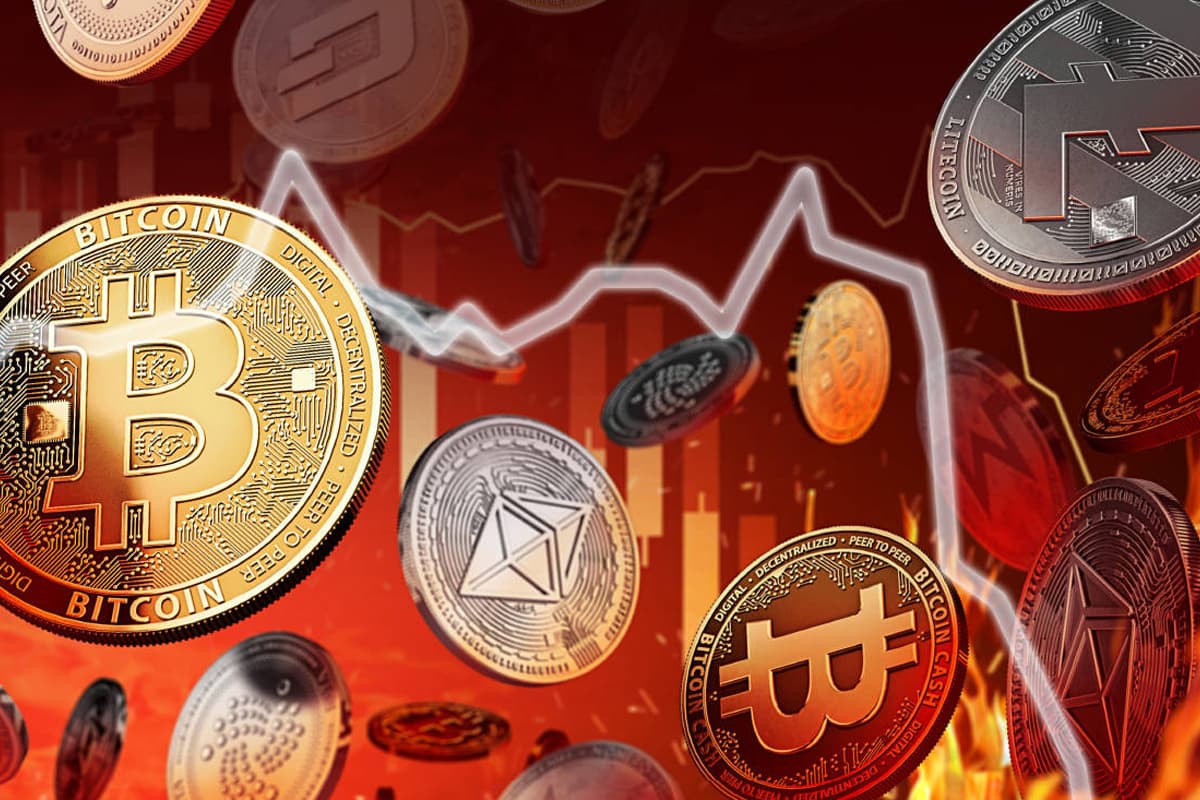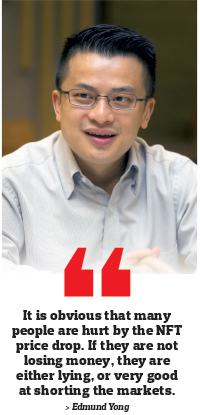
This article first appeared in Wealth, The Edge Malaysia Weekly on June 27, 2022 - July 3, 2022
Many non-fungible tokens (NFTs) are traded in Ether, the cryptocurrency that underpins the Ethereum blockchain. Given that the price of Ether has collapsed, many NFT holders locally suffered huge losses this month.
Edmund Yong, a partner at bespoke blockchain consultancy firm Celebrus Advisory, says the price of Ether has collapsed by more than 70% from over RM15,000 at the end of last year to RM4,450 (as at June 15), not to mention the fall in the price of the NFTs themselves.
“It is obvious that many people are hurt by the NFT price drop. If they are not losing money, they are either lying, or very good at shorting the markets. But very few people do the latter. Everything sinks. Nothing [in the crypto space] has moved up much in the past few weeks.”
However, just like investors in stock markets, very few people talk about losing money in NFTs. “People tend to show how much money they make, but keep quiet when they lose it,” he adds.
Another industry player who does not want to be named concurs with this view. “The mainstream NFT digital arts and those associated with play-to-earn blockchain games, such as Bored Ape Yacht Club and Aurory, have all gone down.”
As at June 15, the floor price for a Bored Ape Yacht Club NFT, once a symbol of rising valuations in the NFT market, was down 78% from April last year, according to news reports. The price dropped below US$100,000 for the first time in almost a year.
“I think the prices of NFTs are going down anyway, sooner or later. Prices of these NFTs [digital arts and games] are built based on momentum, not real value. Anything that is built on momentum through the promotion of celebrity and FOMO (fear of missing out) dies down as quickly as they were built up.”
Prices of many NFTs were also inflated as a result of syndicates trading among themselves. “We call it ‘circle-jerking’, and we ‘circle-jerk’ each other’s NFTs to increase the prices. But nowadays, people are quite smart lah. They don’t have as much money in their pockets to play around with as before.
“During the upcycle, people made a lot of money from meme coins such as Shiba Inu and Dogecoin, and they didn’t know where to spend [the gains]. They spent it on all kinds of NFTs. There was this liquidity overflow. But now, it is tight. Most people are looking for value instead of hype.”
The same industry player also points out that many Malaysians have been badly hurt by the collapse in the price of Terra Luna (UST). They held UST while performing lending and borrowing activities on the Terra blockchain to earn attractive rewards. The yield they earned could go as high as 20%. It was a profitable venture before things went wrong.
“A lot of people were burnt when its price collapsed, including me. My portfolio was 100% burnt. I put a sizeable chunk [of my money] into it.
“But it’s ok lah. I’m actually quite kan de kai (Mandarin for ‘can accept an unpleasant experience’). Crypto money comes easy, and you lose it easily. There are still other opportunities moving forward, especially in the DeFi (decentralised finance) and metaverse space.”
Crypto prices increasingly correlated to traditional asset classes
It is becoming harder to regard cryptocurrency as an asset class with a low correlation to the traditional financial markets. The industry player says this is likely due to the flood of venture capitalists (VCs) and hedge funds into cryptocurrencies in the past few years.
“Traditional VCs have pumped a lot of money into the crypto space recently.
“They would, let’s say, get heavily involved in the mining, lending and borrowing activities of cryptocurrencies to earn an interest of 0.5% above market rates. They could make a lot if they were to put, for instance, RM200 million in it.
“However, now that interest rates have risen, and could continue to rise, it is no longer profitable for them to do so. So, they pull out their money.
“People are finding it hard to justify the narrative that crypto prices are not correlated with traditional market prices. Many cannot answer whether it is a hedge against traditional markets, or just an extension of the traditional market.”
Another example of the increasing correlation between cryptocurrencies and traditional asset classes is the fall in the share price of MicroStrategy. According to The Wall Street Journal, the business intelligence company held 129,218 Bitcoins worth US$5.9 billion in March. The company’s share price plunged 25% on June 14 when Bitcoin prices dived further as Celcius, one of the largest cryptocurrency lending platforms in the world, froze withdrawals, citing “extreme” market conditions.
NFTs gaining traction among corporations
Nevertheless, NFTs are growing popular with corporations globally, including in Malaysia. “Companies are using it for merchandising, brand engagement or loyalty programmes. I would summarise it as a souvenir market. Or you can call it collectibles,” says Celebrus’ Yong.
For instance, KFC Malaysia launched 11 NFTs in May and provided holders with perks, including an RM20 discount off delivery orders made through its mobile application or website, each month.
Earlier in January, Heineken launched its NFTs for Tiger Beer where proceeds used to buy the NFTs went towards supporting local musicians and artists.
Allen Yeong, managing director of investor relations firm Turing Alpha Sdn Bhd, observes such a trend spreading in Malaysia. He says a public-listed property company is in the midst of launching its own NFTs soon.
“The company intends to let its NFT holders earn a referral fee when they refer the company’s properties to buyers. The holders can also access the rooftop of one of the company’s hotels in Genting. They can enjoy the sunrise, sunset, while having a beer or coffee.
“The company also intends to earn a royalty fee whenever its NFTs are traded in the secondary market. The money can be used to improve user experience and for other purposes,” Yeong explains.
A Malaysian retail group that is involved in international luxury fashion and lifestyle brands also launched NFTs recently. Users of its app can purchase the NFTs in fiat money and enjoy benefits such as discounts when purchasing exclusive items.
While companies are now more worried about whether their NFT projects can take off because of the negative sentiment in the cryptocurrency market, Yeong believes the trend is here to stay as it is a new way for companies to engage clients.
“While they are worried about NFTs’ prices over the short term, they shouldn’t worry about using them for branding, marketing and client engagement over the long term. Technology evolves; so does human behaviour,” he says.
Save by subscribing to us for your print and/or digital copy.
P/S: The Edge is also available on Apple's App Store and Android's Google Play.


